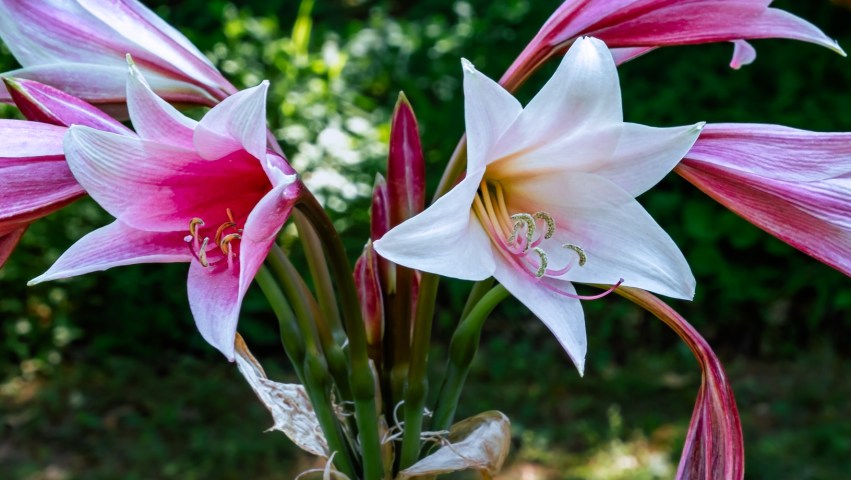From “In a Quiet Light” in Amaryllis by Starr Ockenga:
“Looking through the lens of a camera at a flower is intoxicating, particularly close up as it morphs from reality into abstraction.…
“Besides being seduced by the plant as a subject for my camera, I also became curious about its history. What does the name amaryllis mean? In what tropical paradise did its ancestors originate? What plant hunters’, botanists’, and breeders’ names are linked to it? Where and how is the bulb propagated today? How is its anatomy defined? What is the plant’s range of color and form? What is the best way to grow it, and under what conditions can it be rejuvenated year after year?”
From “Amaryllis” in The English Flower Garden by William Robinson:
“Amaryllis: Showy bulbous tropical plants, few of the species of which are hardy, though the beautiful Belladonna Lily (A. belladonna) may be grown well in the open air…. It is a noble bulbous plant from the Cape of Good Hope, from 1 feet to 3 feet high, blooming late in summer, the flowers, as large as the white Lily, and of delicate silvery rose in clusters on stout, leafless stems, arising from the large pear-shaped bulbs….
“If planted in autumn, or at any time during the winter, it will be well to protect them from severe weather by half-rotten leaves, coconut fibre, or fern. The plants begin to push forth their new leaves early in spring, and upon the freedom with which they send forth these during summer the bloom in the autumn depends.”
Hello!
This is the first of three posts featuring photos of Amaryllis buds and blooms that I took at Oakland Cemetery’s gardens on two separate visits. The photos in this post are from mid-June, which seems like the optimal blooming time for these large pink and magenta variations, as well as a few white ones that I’ll include in the next post. The second and third posts will also include some I took just yesterday — on one of the few July days when it was not raining or so humid it felt like walking through rainclouds — when I found a batch of late-bloomers showing off deep red and purple flowers, instead of the lighter pink/magenta or white you see here.
Amaryllis is among the many plants often mischaracterized as lilies (see List of plants known as lily for lots of others) — and I mention this only because I too thought they were lilies until a couple of years ago. The appearance of the opened flowers is very lily-like; but mostly I mis-knew them because they’re often referred to as “swamp lilies” — a common name I recognized. And actually it’s crinum — a member of the Amaryllis family — to which “swamp lily” is frequently applied, though it’s quite a challenge to differentiate between amaryllis as an Amaryllis-family variety and crinum when you didn’t plant the plants yourself.
Thanks for taking a look!
















How lovely these are!
Yes, they’re awesome! and thanks!
🙂